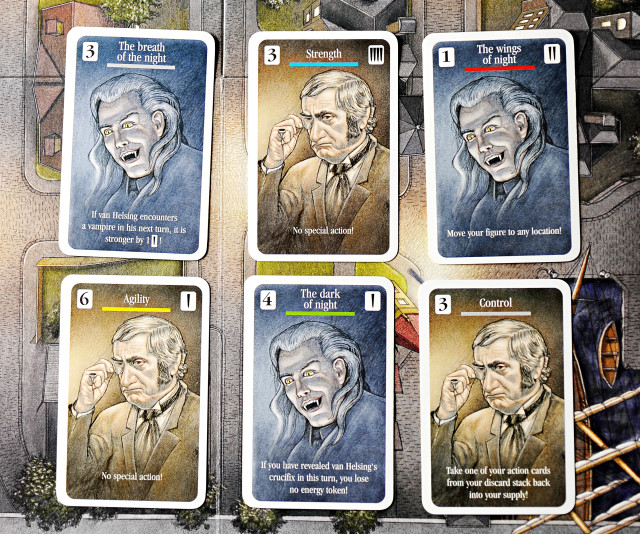I grew up a fan of classic monsters and monster movies. The Monster Squad came out at the perfect time to make a big impression on me and Bram Stoker’s Dracula haunted my teenage years. Francis Ford Coppola and Gary Oldman combined to make a luscious nightmare of a film, filled with such dark imagery that it stays with me still today.
I was excited to try out Dracula and see if it held any of the horror and mystery of the classic legend. Dracula is a two-player game designed by Michael Rieneck. It has a similar feel to Mr Jack, with one player taking the role of the infamous bloodsucker and the other playing Dr Van Helsing, pursuing the vampire through the streets of London.
The board is made up of 12 different locations including the Harbour, where Dracula begins, and the Coach House, the starting space for Van Helsing. Four different coloured barriers create problems for the two characters moving a round the board. Each player has a deck of 15 encounter cards, four energy cubes and ten action cards. Dracula’s encounter deck is made up of vampire slaves, coffins and an amulet of power. Van Helsing draws from an encounter deck made from vampire hunters, a crucifix and potential victims. At the start of the game each player selects six of their encounter cards. They get shuffled together and then laid out, face-down on the 12 different locations on the board.
It’s up to Van Helsing to track down Dracula’s five coffins before the five victims have been found. These are the target cards. On each turn players will select an action card from their hand which informs a number of different elements. The top right number indicates how far their character can move through London on a turn. The stakes or fangs indicate battle strength. The coloured line allows the active player to move a barrier of that colour. The only rule for barriers is that the four of them cannot split the board into two separate parts. Finally (most) cards have a special action. This can range from ‘Move any figure to the Harbour’ to ‘Take one of your Action Cards back into your hand.’ When deciding what Action card to play you have to weigh all of the different stats and find the one that is going to be the most advantages to the current board conditions.  When a player finishes their turn on a location they may look at the encounter card that’s been placed there. If it’s one of their own they take it to their supply and place a card back on that location. They may even place the same card back down if they want. If it’s an opponent’s card then a few things might occur. For Van Helsing, finding a coffin is great! He collects it and places it face-up in his play area, one step closer to ending the vampire’s reign of terror in London. Dracula is searching for victims to feed his insatiable thirst. Five victims or coffins found will win the game for either player.
When a player finishes their turn on a location they may look at the encounter card that’s been placed there. If it’s one of their own they take it to their supply and place a card back on that location. They may even place the same card back down if they want. If it’s an opponent’s card then a few things might occur. For Van Helsing, finding a coffin is great! He collects it and places it face-up in his play area, one step closer to ending the vampire’s reign of terror in London. Dracula is searching for victims to feed his insatiable thirst. Five victims or coffins found will win the game for either player.
When the card revealed is a Vampire for Van Helsing or Hunter for Dracula then a battle occurs. If the battle strength of the action card is stronger than the encounter card then the battle is won by the active player. The encounter card is discarded and the active player places down an encounter card of their own, gaining further control of the board. If the encounter card is stronger it stays in place and the active player discards an energy cube…run out of those and it’s game over.
If Van Helsing finds the amulet or Drac finds the crucifix then they lose an energy cube as well.
There is a way to end the game prematurely if both players end up on the same space. The active player may choose to have both players show their stack of encounter cards not on the board. If it’s revealed that a player has none of their target cards left on the board (i.e. all of Van Helsing’s victims are either captured by Dracula or in his own encounter deck) then the game ends and the active player wins.
Dracula is a game of memory and bluffing. Because cards get changed so much throughout the course of the game it can be tough to remember what was where and whether or not a card has been switched out. It’s also a bit of push your luck. How many coffins do you want to risk putting out on the board for Van Helsing to discover VS. do you want to risk getting caught with all of them in your encounter deck, costing you the game.
This is a fun little romp that is simple to learn, but entertaining and replayable. Dracula is perfect for a couple of horror fans to pull out on a dark and stormy night to see who will win the war between good and evil, darkness and light.
Comments
No comments yet! Be the first!